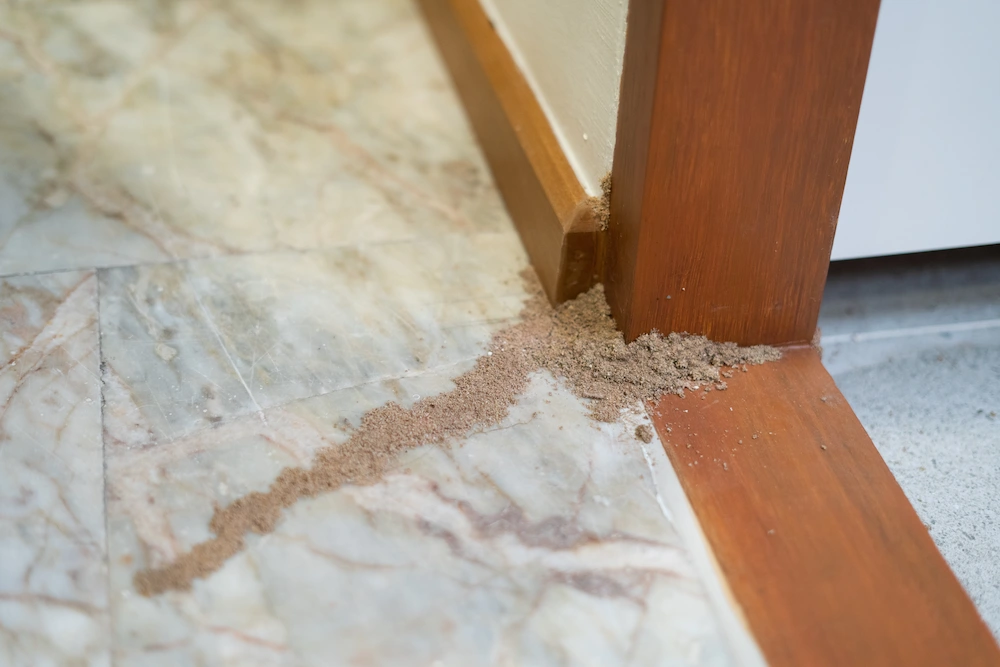11 Frustrating Signs of Termite Invasions — A Quick Guide
11 Frustrating Signs of Termite Invasions — A Quick Guide
Summary: The signs of an invasion are a crucial part of termite awareness. This blog details the 11 most common signs of an invasion, including the appearance and location of each sign. It then discusses effective prevention tips for homeowners to implement. Green Pest Services provides targeted treatments for local termite issues.
In case no one has said it to you yet — and we’re not sure who would — happy Termite Awareness Week! This week is all about raising awareness of these wood-eating pests and all of the destruction they cause. For starters, did you know that termites cause billions of dollars in structural damage every year? Talk about being small yet mighty!
The Signs

It’s important for every homeowner to be aware of termites and keep an eye out for the warning signs of an infestation. You don’t have to constantly wonder if termites are around (trust us, you’ll know) and be worried for your home. However, awareness is essential with these pests.
Let’s discuss the infamous signs of an invasion before we get into our top prevention tips!
Wood Damage
These pests target wooden objects and structures because wood contains cellulose, an organic polymer. This is what termites are technically eating since their tiny bodies are only able to digest cellulose. All of that to say, “random” wood damage is usually the first sign of an invasion. Weathering, splintering, tunnels, and holes in the wood — especially when the wood is otherwise healthy — are often an indicator of termite issues. It’s worth looking into the source of these problems, if only to find the real reason behind the damage.
Mud Tubes
Mud tubes are tightly-packed lines of dirt that these bugs create over their interior tunnels. These tubes provide more insulation and warmth for their galleries. They also serve as additional protection against predators that want to destroy the tunnels. Mud tubes look like lines of hard dirt on the exterior of the building or house. Termites travel upward as they tunnel, so the tubes gradually get taller. Subterranean termites also create mud tubes when they’re underground, so you may see raised lines of dirt in the yard if these pests are around.
Hollow-Sounding Wood
When you knock on healthy wood, it has a dense sound. When you knock on wood that’s overrun by termites, it sounds much more hollow. This applies to walls, floors, and furniture. The more that the pests carved out of the wood, the more hollow it will sound when tapped. You don’t have to knock on every wall and floor in your house (unless you want to), but it might help to tap on the spaces that you believe contain a colony.
Swarms
The reproductives are also called “swarmers” for their habit of flying in big swarms when they’re looking for mates. These swarms usually happen in spring and summer because these pests are more active in warm weather. Swarmers leave their original nests to mate and locate a great location for their new nests. If you see flying termites (they look like flying ants) around your home, they’re looking for a nesting location and will start reproducing soon.
Frass
As gross as it is, we need to talk about droppings. These are another clear sign of an invasion, especially if the piles (yes, piles) are pretty big. Like us, termites like to keep a clean home. This is why they push their droppings — aka frass — out of their tunnels and onto the ground below. Small piles of sawdust-like frass at the base of a wall or doorframe indicate that a colony is living inside.
Tunnels
Termite tunnels and galleries are usually well-hidden, but some of them are able to be seen just by looking closely. In fact, these tunnels are the clear distinction between these pests and natural damage. Rot and moisture damage don’t create smooth tunnels, but termites do! From our vantage point outside the wood, the tunnels can look like smooth lines going further into the wood or like a honeycomb pattern of holes.
Discarded Wings
Remember the swarmers we mentioned earlier? Well, they never clean up after themselves! They shed their wings after mating and leave them behind as they move into their new nests. These wings are an odd, kind of haunting sight when they collect on windowsills and floorboards. They’re brown and rounded on the ends, and are usually found in piles when there was a major swarm. If you find scattered wings, look around for other signs of termite damage.
Flooring Issues
The longer that termites stay in the floorboards, the more obvious the damage will become. We typically notice issues with the flooring first because we walk on it every day, so any differences will be pretty obvious. The additional moisture that these pests add to their habitats doesn’t mix well with the types of flooring in most houses. Hardwood or tile floors that are suddenly loose, sagging, buckling, or squeaky may have a colony hidden underneath.
Tiny Holes
These pests are definitely not friends of people with trypophobia, the fear of tiny holes. When these pests invade a house or building, they need to create entrance holes in the wall they want to inhabit. Termites easily eat through drywall, so these holes are seen in most types of walls. These pin-sized holes can be hard to see when there’s just one or two, but a collection of these holes is much more obvious.
Moldy Odor
A high concentration of termites in one area results in a moldy smell. This is for a few reasons, the largest one being that termites bring more moisture into indoor areas. In fact, this additional moisture can introduce actual mold, which wouldn’t help with the odor at all. Besides this, a huge gathering of bugs simply doesn’t smell great! A general sign of many pest invasions is a musty or moldy odor in a certain area, and these pests are no different.
Bubbling Paint
Similar to floors, painted walls are impacted by the extra moisture that these pests introduce. The paint becomes uneven and starts bubbling when there’s excessive moisture behind the wall. This won’t happen with just a few bugs. Once the paint on an infested wall starts bubbling, the infestation has grown to a concerning size and needs to be stopped immediately.
How to Prevent Termites This Year

Now that you know the most evident signs of a termite invasion, it’s time to move into the “action” portion of this discussion. There are plenty of ways to prevent these wood-eaters from ruining your home. The good news is that most of these are basic tasks that you probably already do! If these aren’t a part of your chore routine, we recommend adding them to your ongoing to-do list this year.
These are our favorite ways to prevent termites:
- Make sure the gutters and downspouts properly pour water away from the house’s foundation
- Fix any leaks in and around the house (plumbing, garden hose, etc.) as soon as possible
- Use a dehumidifier in rooms that get too humid, like bathrooms and laundry rooms
- Trim back plants and tree branches from the house by at least one foot
- Store firewood at least 20 feet away from the house
- Check your walls and ceilings for any signs of moisture damage, especially after a rainstorm
- Inspect your outdoor wooden objects (fence, trellis, shed, playground, etc.) often for signs of an invasion
- Schedule a professional inspection with your local pest experts to ensure there isn’t termite activity on your property
Safeguard Your Home with Green!
The last thing you need in your home is an army of hungry termites! At Green Pest Services, our licensed technicians target the root of invasions by implementing long-term solutions. We use the Sentricon® system with Always Active™ technology for termite issues because it continuously targets and prevents infestations.
Our certified team members perform routine checks on the system to ensure it’s impacting the pests. But in between visits, you can be sure that the Sentricon® system is actively guarding your home against these destructive invaders. Get ahead of these problematic pests and contact us today to schedule a termite inspection!
Citations
List: Top 5 signs of a termite infestation. (n.d.). Pest World. Retrieved March 5, 2025, from https://www.pestworld.org/news-hub/pest-articles/list-top-5-signs-of-a-termite-infestation/
Termite damage identification at Virginia homes. (n.d.). ExtermPro. Retrieved March 5, 2025, from https://www.extermpro.com/termite-damage-identification-virginia-homes/
Termites. (n.d.). Pointe Pest Control. Retrieved March 5, 2025, from https://pointepestcontrol.com/services/termites/
Summer is Ending, But Pests are Still Going Strong
Summer is Ending, But Pests are Still Going Strong Summer is Ending, But Pests are Still Going Strong Summary: Summer is coming to [...]
10 Tips for Going Back to School Pest-Free
10 Tips for Going Back to School Pest-Free 10 Tips for Going Back to School Pest-Free Summary: The school year is a busy [...]
What is Bug Spray, Really?
What is Bug Spray, Really? What is Bug Spray, Really? Summary: Bug spray is a great tool for preventing pests during outdoor activities, [...]
The Various Personalities of Stinging Pests
The Various Personalities of 5 Stinging Pests The Various Personalities of 5 Stinging Pests Summary: Stinging insects are among the most common summer [...]
8 Creative Ways to Have a Pest-Free Fourth of July
8 Creative Ways to Have a Pest-Free Fourth of July 8 Creative Ways to Have a Pest-Free Fourth of July Summary: The Fourth [...]
A Simple Guide to Preventing Stinging Pests
A Simple Guide to Preventing Stinging Pests A Simple Guide to Preventing Stinging Pests Summary: Stinging insects are more active in warm weather, [...]

